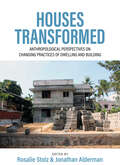- Table View
- List View
Household Finance
by Dimitris N. ChorafasThe 'good life' for households has passed. The unwanted result which accompanied it is the sea of red ink. Confidence in the western way of life will not return until the current mess of a dysfunctional society, and its economy, is cleared out. Household Finance explains why and how this can be done.
Household and Living Arrangement Projections
by Kenneth C. Land Yi Zeng Danan Gu Zhenglian WangThis book presents an innovative demographic toolkit known as the ProFamy extended cohort-component method for the projection of household structures and living arrangements with empirical applications to the United States, the largest developed country, and China, the largest developing country. The ProFamy method uses demographic rates as inputs to project detailed distributions of household types and sizes, living arrangements of all household members, and population by age, sex, race/ethnicity, and urban/rural residence at national, sub-national, or small area levels. It can also project elderly care needs and costs, pension deficits, and household consumption. The ProFamy method presented herein has substantial merits compared to the traditional headship rate method, which is not linked to demographic rates and projects limited household types without other household members than "heads". The book consists of four parts. The first part presents the methodology, data, estimation issues, and empirical assessments. The next parts present applications in the United States (part two) and China (part three), concerning demographic, social, economic, and business research; policy analysis, including forecasting future trends of household type/size, elderly living arrangements, disability, and home-based care costs, and household consumption including housing and vehicles. The fourth part includes a user's guide for the ProFamy software to project households, living arrangements, and home-based consumptions. This book offers an invaluable toolkit for researchers, analysts and students in academic, public and private businesses, whose work is related to levels and rates of change in households, population and consumption patterns.
Households as Corporate Firms
by Krislert Samphantharak Robert M. TownsendThis investigation proposes a conceptual framework for measurement necessary for an analysis of household finance and economic development. The authors build on and, where appropriate, modify corporate financial accounts to create balance sheets, income statements, and statements of cash flows for households in developing countries, using an integrated household survey. The authors also illustrate how to apply the accounts to an analysis of household finance that includes productivity of household enterprises, capital structure, liquidity, financing, and portfolio management. The conceptualization of this analysis has important implications for measurement, questionnaire design, the modeling of household decisions, and the analysis of panel data.
Houses Transformed: Anthropological Perspectives on Changing Practices of Dwelling and Building
by Rosalie Stolz Jonathan AldermanOver the decades, there has been a world-wide transformation of so-called ‘vernacular houses’. Based on ethnographic accounts from different regions, Houses Transformed investigates the changing practices of building houses in a transnational context. It explores the intersection of house biographies and social change, the politics of housing design, the social fabrication of aspirational houses, the domestication of concrete and the intersection of materiality and ontology as well as the rhetoric of the vernacular. The volume provides new anthropological pathways to understanding the dynamics of dwelling in the 21st century.
Houses in Motion
by Richard BaxstromBaxstrom (social anthropology, U. of Edinburgh) offers plenty of personal experience in the Brickfields neighborhood of Kuala Lumpur, working from a broad array of interviews and primary sources, to explain why forces of reform in the largely Muslim government of Malaysia tried urban renewal without asking residents what they needed or wanted. It appears that Brickfields was a particularly good example of marginalization, and Baxstrom details the development of Brickfields, the rise of Islamic reform in the region, the trajectory of urban government in Kuala Lumpur, the experience of place in radical transformation, the concept of belonging, and the role of ambivalence in making a place to live. Annotation ©2008 Book News, Inc. , Portland, OR (booknews. com)
Houses in Motion: The Experience of Place and the Problem of Belief in Urban Malaysia
by Richard BaxstromThe book is about the transformation of urban space and the reordering of the demographic character of Brickfields, one of the oldest neighborhoods in Kuala Lumpur.
Housing America: Issues and Debates (The Metropolis and Modern Life)
by Emily Tumpson MolinaIn an effort to explain why housing remains among the United States’ most enduring social problems, Housing America explores five of the U.S.’s most fundamental, recurrent issues in housing its population: affordability of housing, homelessness, segregation and discrimination in the housing market, homeownership and home financing, and planning. It describes these issues in detail, why they should be considered problems, the history and fundamental social debates surrounding them, and the past, current, and possible policy solutions to address them. While this book focuses on the major problems we face as a society in housing our population, it is also about the choices we make about what is valued in our society in our attempts to solve them. Housing America is appropriate for courses in urban studies, urban planning, and housing policy.
Housing Booms in Gateway Cities (IJURR Studies in Urban and Social Change Book Series)
by David LeyHOUSING BOOMS IN GATEWAY CITIES “David Ley examines the development of housing booms, and policies intended to stimulate or limit them. Utilising a comparative approach in five gateway cities, he provides a superb understanding of the politics of booms, lifting the debate beyond narrow housing and real estate studies. This book is required reading for anyone interested in global cities, housing markets, or comparative urbanism.” —Manuel B. Aalbers, Professor of Human Geography, KU Leuven, Belgium “A stellar contribution to housing and its financialisation as central to the capitalist project globally, Housing Booms offers a wonderful window into the ascendancy of the secondary circuit of real estate in Singapore, Hong Kong, Sydney, Vancouver, and London. Critically, through careful, empirically rigorous comparison, an eminent urban social scientist urges us to understand the importance of placing urban housing theoretically.” —Loretta Lees, Director of the Initiative on Cities, Boston University “Mastering a wealth of information and insights from five gateway cities, David Ley provides fresh and inspiring explanation of both common global logics and diverse local trajectories of housing booms in the era of financialisation and asset-based accumulation. A timely and ground-breaking contribution, (re)positioning housing to the centrality pervasively felt in everyday life but largely unacknowledged in mainstream social science.” —George Lin, Chair Professor of Geography, University of Hong Kong In Housing Booms in Gateway Cities, renowned geographer Dr. David Ley delivers a detailed exploration of housing markets in Hong Kong, Singapore, Sydney, Vancouver, and London and explains why these gateway cities have seen dramatic increases in residential real estate prices since the 1980s. The author describes how the globalization of real estate has rapidly inflated demand and uncoupled local housing prices from local wages, causing acute problems of affordability, availability, and inequality. The book implicates government policy in massive real estate price inflation, describing a shift from welfare-based to asset-based societies. It also highlights the relatively unique experience in Singapore, where asset-based housing policy has encouraged the dispersion of ownership and accumulation through an increased supply of subsidized leasehold apartments and the regulation of disruptive investment flows. Housing Booms in Gateway Cities is an ideal resource for academics, students and policymakers with an interest in urban geography, sociology, and planning, housing studies, and any of the cities discussed in the book. It is an innovative treatment of housing as a central category in wealth accumulation in urban economies and societies.
Housing Estates in Europe: Poverty, Ethnic Segregation And Policy Challenges (The Urban Book Series)
by Daniel Baldwin Hess Maarten Van Ham Tiit TammaruThis open access book explores the formation and socio-spatial trajectories of large housing estates in Europe. Are these estates clustered or scattered? Which social groups originally had access to residential space in housing estates? What is the size, scale and geography of housing estates, their architectural and built environment composition, services and neighbourhood amenities, and metropolitan connectivity? How do housing estates contribute to the urban mosaic of neighborhoods by ethnic and socio-economic status? What types of policies and planning initiatives have been implemented in order to prevent the social downgrading of housing estates?The collection of chapters in this book addresses these questions from a new perspective previously unexplored in scholarly literature. The social aspects of housing estates are thoroughly investigated (including socio-demographic and economic characteristics of current and past inhabitants; ethnicity and segregation patterns; population dynamics; etc.), and the physical composition of housing estates is described in significant detail (including building materials; building form; architectural and landscape design; built environment characteristics; etc.). This book is timely because the recent global economic crisis and Europe’s immigration crisis demand a thorough investigation of the role large housing estates play in poverty and ethnic concentration. Through case studies of housing estates in 14 European centers, the book also identifies policy measures that have been used to address challenges in housing estates throughout Europe.
Housing Estates in the Baltic Countries: The Legacy of Central Planning in Estonia, Latvia and Lithuania (The Urban Book Series)
by Daniel Baldwin Hess Tiit TammaruThis open access book focuses on the formation and later socio-spatial trajectories of large housing estates in the Baltic countries—Estonia, Latvia, and Lithuania. It also explores claims that a distinctly “westward-looking orientation” in their design produced housing estates that were superior in design to those produced elsewhere in the Soviet Union (between 1944 and 1991, Estonia was a member republic of the USSR). The first two parts of the book provide contextual material to help readers understand the vision behind housing estates in Estonia, Latvia, and Lithuania. These sections present the background of housing estates in the Baltic Republics as well as challenges and debates concerning their formation, evolution, and present condition and importance. Subsequent parts of the book consist of:demographic analyses of the socioeconomic characteristics and ethnicity of housing estate residents (past and present) in the three Baltic capital cities, case studies of people and places related to housing estates in the Baltic countries, and chapters exploring relevant special topics and themes.This book will be of interest to students, scholars, and advocates interested in understanding the past, present, and future importance of housing estates in the Baltic countries.
Housing Improvement and Social Inequality: Case Study of an Inner City
by Paul N. BalchinOriginally published in 1979, this book discusses housing improvement, and particularly its effects upon the residential population of the inner areas of West London. The economic and social rationale is explained, and the role of landlords, developers and local authorities is analysed. The book concentrates both on the defects of the improvement process as a whole, and on the application of housing legislation within a specific geographical area. Housing improvement is related to the debate about the inequality of wealth by implicitly questioning who benefits and who loses from improvement policy.
Housing Market Renewal and Social Class (Housing, Planning and Design Series)
by Chris AllenHousing market renewal is one of the most controversial urban policy programmes of recent years. Housing Market Renewal and Social Class critically examines the rationale for housing market renewal: to develop 'high value' housing markets in place of the so-called 'failing markets' of low-cost housing. Whose interests are served by such a programme and who loses out? Drawing on empirical evidence from Liverpool, the author argues that housing market renewal plays to the interests of the middle classes in viewing the market for houses as a field of social and economic 'opportunities', a stark contrast to a working class who are more concerned with the practicalities of 'dwelling'. Against this background of these differing attitudes to the housing market, Housing Market Renewal and Social Class explores the difficult question of whether institutions are now using the housing market renewal programme to make profits at the expense of ordinary working-class people. Reflecting on how this situation has come about, the book critically examines the purpose of current housing market renewal policies, and suggests directions for interested social scientists wishing to understand the implications of the programme. Housing Market Renewal and Social Class provides a unique phenomenological understanding of the relationship between social class and the market for houses, and will be compelling reading for anybody concerned with the situation of working class people living in UK cities.
Housing Movements in Rome: Resistance and Class (Alternatives and Futures: Cultures, Practices, Activism and Utopias)
by Carlotta CaciagliThis book explores contemporary challenges of housing movement organizations, looking specifically at the case of Rome, Italy. The work identifies conditions that allow the re-composition of a class of housing dispossessed and, consequently, the features of its action in urban spaces. The book offers fresh analytical perspectives to understanding contemporary urban transformation via new spatial and strategic approaches. In striking detail, Carlotta Caciagli shows how space is a crucial variable in shaping the strategies that allow for the politicisation of a movement’s social base. She illustrates how new spatial configurations of urban space result from unique struggles of the recomposed collective subject. Most notably, three main conceptual tools are introduced to disentangle the relationship between the recomposed precarious class and space: “the spatial opportunity structure”, “configurations of strategies” and “educational sites of resistance”.
Housing Needs and Planning Policy: Problems of Housing Need & `Overspill' in England & Wales (International Library of Sociology #Vol. 185)
by J.B. Cullingworth J Barry CullingworthIn seeking to understand society sociologists in the Public Policy, Welfare and Scoial Work set of the International Library of Sociology consider the policy and planning implications of attempts to respond to and meet social needs by the Church, Civil Service, Industry and Voluntary Organizations.
Housing Policy In The United States: An Introduction
by Alex F. SchwartzHousing Policy in the United States is an essential guidebook to, and textbook for, housing policy, it is written for students, practitioners, government officials, real estate developers, and policy analysts. It discusses the most important issues in the field, introduces key concepts and institutions, and examines the most important programs. Written as an introductory text, it explains all concepts, trends, and programs without jargon, and includes empirical data concerning program evaluations, government documents, and studies carried out by the author and other scholars. The first chapters present the context surrounding US housing policy, including basic trends and problems, the housing finance system, and the role of the federal tax system in subsidizing homeowner and rental housing. The middle chapters focus on individual subsidy programs. The closing chapters discuss issues and programs that do not necessarily involve subsidies, including homeownership, mixed-income housing, and governmental efforts to improve access to housing by reducing discriminatory barriers in the housing and mortgage markets. The concluding chapter also offers reflections on future directions of US. housing policy.
Housing Policy and Equality: A Comparative Study of Tenure Conversions and Their Effects (Routledge Library Editions: Inequality #6)
by Lennart J. LundqvistOriginally published in 1986, this book compares and evaluates the effects of converting rental housing into owner occupancy in the USA, the UK and Germany. The evaluation examines the pros and cons of such conversions. The conversion controversy is more than a technical discussion of outcomes of different housing strategies. By viewing tenure conversions as strategies for limiting direct governmental involvement, this comparative evaluation indicates something about the effects not only on housing, but on general social welfare, of such strategies.
Housing Policy and Vulnerable Families in The Inner City: Public Housing in Harlem, New York City (SpringerBriefs in Geography)
by Brigitte ZamzowThis book provides insights in how the lack of coherent social policy leads to the displacement of vulnerable low-income families in inner-city neighborhoods facing gentrification. First, it makes a case for how social policy by its racist setup has failed vulnerable families in the history of U.S. public housing. Second, it shows that today’s public housing transformation puts the same disadvantaged socio-economic clientele at risk, while the neighborhoods they call their homes are taken over by gentrification. It raises the powerful argument that the continuing privatization of Housing Authorities in the U.S. will likely lead to greater income diversity in formerly neglected neighborhoods, but it will happen at the expense of vulnerable families being displaced and resegregated further outside the city, if no regulatory planning measures for their protection are initiated by the government. By providing a solid empirical portrait of public housing in New York City’s Harlem, this book provides a great resource to students, academics and planners interested in gentrification with specific concern for race and class.
Housing Policy in Australia: A Case for System Reform
by Judith Yates Hal Pawson Vivienne MilliganThis book, the first comprehensive overview of housing policy in Australia in 25 years, investigates the many dimensions of housing affordability and government actions that affect affordability outcomes. It analyses the causes and implications of declining home ownership, rising rates of rental stress and the neglect of social housing, as well as the housing situation of Indigenous Australians. The book covers a period where housing policy primarily operated under a neo-liberal paradigm dominated by financial de-regulation and fiscal austerity. It critiques the broad and fragmented range of government measures that have influenced housing outcomes over this period. These include regulation, planning and tax policies as well as explicit housing programs. The book also identifies current and future housing challenges for Australian governments, recognizing these as a complex set of inter-connected problems. Drawing on its coverage of the economics, politics and administration of housing provision, the book sets out priorities for the transformational national strategy needed for a fairer and more productive housing system, and to improve affordability outcomes for the most vulnerable Australians.
Housing Policy in Australia: A Case for System Reform
by Judith Yates Hal Pawson Vivienne MilliganThis book, extensively revised and updated in its second edition, presents a comprehensive overview of housing policy in Australia over the last quarter century. At a time of widespread concern about declining housing system performance, it investigates the many dimensions of housing affordability and housing wealth inequality, together with government actions affecting these outcomes. The authors analyse the causes and implications of falling home ownership, rising rental stress rates and the long-term neglect of social housing, as well as the housing situation of Indigenous Australians. Building on its analysis of housing policy evolution in modern Australia, this new edition also documents and critiques the numerous government efforts of the early 2020s to halt the decline in housing affordability. These reforms span tenancy regulation, land-use planning and housing supply, first home buyer assistance, and social/affordable housing investment. Throughout, the book identifies current and future housing challenges for Australian governments, recognising these as a complex set of inter-connected problems. Drawing on its coverage of the economics, politics and governance of housing provision, the final chapter outlines a pathway to the transformational national strategy needed for a fairer and more productive housing system.
Housing Policy in Britain: A History
by A. E. HolmansOriginally published in 1987, this book provides a comprehensive history of housing policy in Britain from the beginning of the twentieth century to the end of the 1970s. For every period the author gives a detailed account of the housing situation in which policies operated, the policies pursued and their rationale. Owner-occupation and privately rented housing are fully discussed. Particular emphasis is placed on the financial and economic aspects of housing policy, including the impact on it of the economic situation. Issues such as population growth and the increase in the number of households are also examined.
Housing Policy in the Developed Economy: The United Kingdom, Sweden and The United States
by Bruce HeadeyOriginally published in 1978, this book analyses three main approaches to national housing policy in the 20th Century in Sweden, the UK and USA. It reviews policy developments and considers the impact of policy on the housing conditions and costs of different sections of the community. A major theme is that British and American governments, contrary to their stated objectives, have actually increased housing inequality by allowing homeowners tax concessions which are more generous than the housing welfare programmes available to tenants. The political pressures which produced this outcome in Britain and the USA, but a quite different and more egalitarian outcome in Sweden, are carefully discussed. Throughout the book, policy making is regarded as involving trade-offs between what is politically feasible and what is operationally feasible. This framework enables readers to view policy making from the perspective of politicians and civil servants as they react to diverse demands and pressures and seek to devise housing programmes which embody incentives to which housing financiers builders and consumers will respond.
Housing Policy in the United States
by Alex F. SchwartzThe classic primer for its subject, Housing Policy in the United States, has been substantially revised in the wake of the 2007 near-collapse of the housing market and the nation’s recent signs of recovery. Like its previous editions, this standard volume offers a broad overview of the field, but expands to include new information on how the crisis has affected the nation’s housing challenges, and the extent to which the federal government has addressed them. Schwartz also includes the politics of austerity that has permeated almost all aspects of federal policymaking since the Congressional elections of 2010, new initiatives to rehabilitate public housing, and a new chapter on the foreclosure crisis. The latest available data on housing conditions, housing discrimination, housing finance, and programmatic expenditures is included, along with all new developments in federal housing policy. This book is the perfect foundational text for urban studies, urban planning, social policy, and housing policy courses.
Housing Policy in the United States
by Alex F. SchwartzThe fourth edition of Housing Policy in the United States refreshes its classic, foundational coverage of the field with new data, analysis, and comparative focus. This landmark volume offers a broad overview that synthesizes a wide range of material to highlight the significant problems, concepts, programs and debates that all defi ne the aims, challenges, and milestones within and involving housing policy. Expanded discussion in this edition centers on state and local activity to produce and preserve affordable housing, the impact and the implications of reduced fi nancial incentives for homeowners. Other features of this new edition include: • Analysis of the impact of the Tax Cuts and Jobs Act of 2017 on housing- related tax expenditures; • Review of the state of fair housing programs in the wake of the Trump Administration’s rollback of several key programs and policies; • Cross- examination of U.S. housing policy and conditions in an international context. Featuring the latest available data on housing patterns and conditions, this is an excellent companion for graduate and advanced undergraduate courses in urban studies, urban planning, sociology and social policy, and housing policy.
Housing Policy in the United States
by Alex F. SchwartzThe fourth edition of Housing Policy in the United States refreshes its classic, foundational coverage of the field with new data, analysis, and comparative focus. This landmark volume offers a broad overview that synthesizes a wide range of material to highlight the significant problems, concepts, programs and debates that all defi ne the aims, challenges, and milestones within and involving housing policy. Expanded discussion in this edition centers on state and local activity to produce and preserve affordable housing, the impact and the implications of reduced fi nancial incentives for homeowners.Other features of this new edition include:• Analysis of the impact of the Tax Cuts and Jobs Act of 2017 on housing- related taxexpenditures;• Review of the state of fair housing programs in the wake of the Trump Administration’s rollbackof several key programs and policies;• Cross- examination of U.S. housing policy and conditions in an international context.Featuring the latest available data on housing patterns and conditions, this is an excellent companionfor graduate and advanced undergraduate courses in urban studies, urban planning, sociologyand social policy, and housing policy.
Housing Policy, Wellbeing and Social Development in Asia (Routledge Studies in International Real Estate)
by Rebecca Lai Chiu Seong-Kyu HaThis book investigates how housing policy changes in Asia since the late 1990s have impacted on housing affordability, security, livability, culture and social development. <P><P> Using case study examples from countries/cities including China, Hong Kong, India, Japan, Taiwan, Korea, Malaysia, Bangladesh, Singapore, Indonesia, Thailand and Vietnam, the contributors contextualize housing policy development in terms of both global and local socio-economic and political changes. They then investigate how policy changes have shaped and re-shaped the housing wellbeing of the local people and the social development within these places, which they argue should constitute the core purpose of housing policy. <P><P> This book will open up a new dimension for understanding housing and social development in Asia and a new conceptual perspective with which to examine housing which, by nature, is culture-sensitive and people-oriented. It will be of interest to students, scholars and professionals in the areas of housing studies, urban and social development and the public and social policy of Asia.























